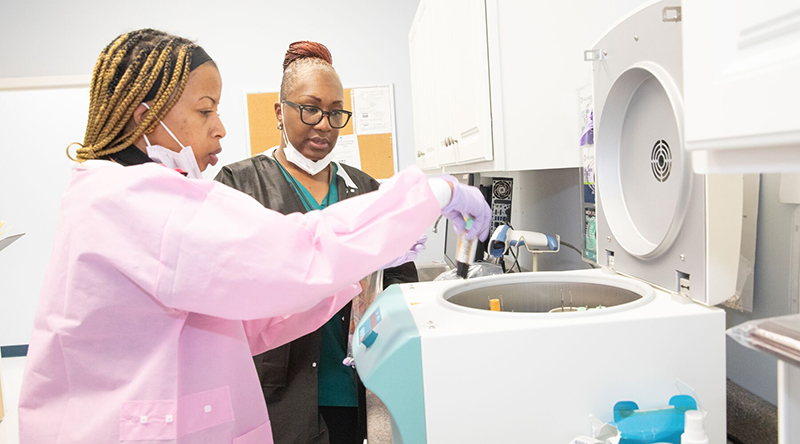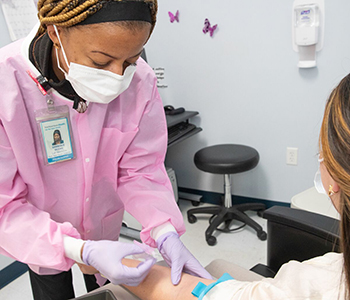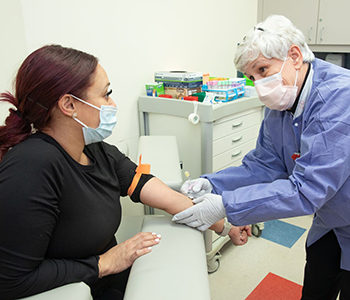-
Services
Featured Specialties
-
Locations
Location Type
-
Patients & Visitors

Phlebotomist Shanique Moore (left) and colleague Cheryl Anderson, outreach phlebotomist II, place blood samples in the centrifuge, a device that rapidly spins the samples to separate components of the blood from the platelets – another duty for phlebotomists.
“I don’t like needles,” is one of the most popular statements phlebotomists are greeted with. While they hear it frequently, Yale New Haven Hospital phlebotomists understand and are respectful of each patient’s concerns and anxieties.
One of the most important roles in health care is the phlebotomist. Simply put, phlebotomists collect blood from patients and prepare the samples for testing. At YNHH, phlebotomists perform these duties and much more.
Part of the Laboratory Medicine Department, phlebotomists perform blood draw services for outpatients and inpatients. There are 20 YNHH outpatient laboratory blood draw stations throughout the local area, staffed by approximately 80 phlebotomists. In addition to drawing blood samples from patients per the orders of a medical provider, outpatient phlebotomists collect samples for respiratory viruses such as COVID, flu and RSV in many locations, as well as urine and stool samples. Plus, they handle administrative tasks, including checking patients in and out and scheduling appointments.
“Our phlebotomists are excellent at what they do,” said Ourania Ouzounidis, senior manager, Outpatient Phlebotomy. “Having blood drawn causes anxiety for many people. In addition to being skilled at the technical part of the role, our phlebotomists are equally skilled at patient interactions, calming anxieties and showing compassion. We receive lots of compliments and accolades for our staff members. We have many patients who insist on meeting with their favorite phlebotomist for their blood draw appointments.”

Moore, who completed the CT Center for Arts and Technology (ConnCAT) Phlebotomy program in 2014, began her YNHH career at Smilow Cancer Hospital before moving to the outpatient draw station. She had to have blood drawn often as a child and remembers how it feels to be the patient, so she does what she can to make her patients comfortable.
Shanique Moore, outpatient phlebotomist II, who sees patients at the Westville (New Haven) Blood Draw Station, takes the challenges in stride.
“I enjoy interacting with patients. If they are anxious or nervous when they come in, I want to put them at ease,” Moore said. “Sometimes I’ll play relaxing music or a recording of calming nature sounds or ask them questions about their favorite topics to help them think about something else.”
The inpatient phlebotomy team, which includes 22 phlebotomists and three leads, is based at the Saint Raphael Campus (SRC) and covers approximately 90 percent of the campus’ blood draw needs.
“Our phlebotomists are available on demand and perform blood draws 24 hours a day, seven days a week,” said Brenda Clay-Ozenne, lab support services/phlebotomy coordinator, Laboratory Medicine. “The inpatient population can present special challenges. Some patients are elderly and/or often quite ill and it can be tough to get the blood needed for a sample. Depending on the circumstances, there can be multiple blood draw orders for the same patient in one day, which can be difficult for the patient and the technician.”
“Our team is always busy,” explained Gabrielle Morales, who has been a phlebotomist for eight years and a lead at the SRC for the past year. “We begin seeing patients as early as 4 am. Those on the first shift sometimes have as many as 240 orders for blood draw to be completed right away so that the results are ready for morning rounds.”
While there are some differences in the roles of inpatient and outpatient phlebotomists, both have many things in common. Whether caring for inpatients or patients at walk-in locations, every day YNHH phlebotomists see patients with different needs and experiences. Some may need blood drawn for routine check-ups, but many are dealing with chronic or debilitating illnesses. Also, many people, whether visiting a walk-in center or as an admitted patient, have anxiety about having blood drawn. Regardless of the patient’s circumstances, phlebotomists in both settings must determine the best way to make a patient comfortable, ease any anxieties and successfully draw the sample needed. They also must be meticulous about documentation, proper patient identification and accurate processing and storage of samples.

Gail Fichtner, lab support services associate (right), has worked at the Saint Raphael Campus for 13 years. She explains it is important to earn the patients' trust in every interaction and that patient care is the number one goal.
The phlebotomists at YNHH range in tenure from three months and right out of training to more than 40 years on the job. There are two main pathways to becoming a phlebotomist – by completing a traditional college or training school phlebotomy program or by on-the-job training. All phlebotomists are encouraged to complete the Phlebotomy Technician Certification exam. Many at YNHH begin their careers as phlebotomists and use that experience to move on to other clinical positions.
Morales added, “while our jobs can sometimes be really challenging, we depend on each other and pull together, especially when the schedule becomes overwhelming. Our team works together like a family – we get the job done.”